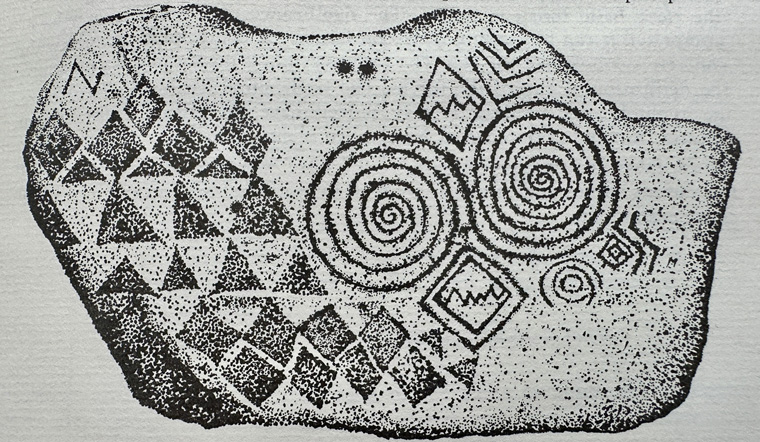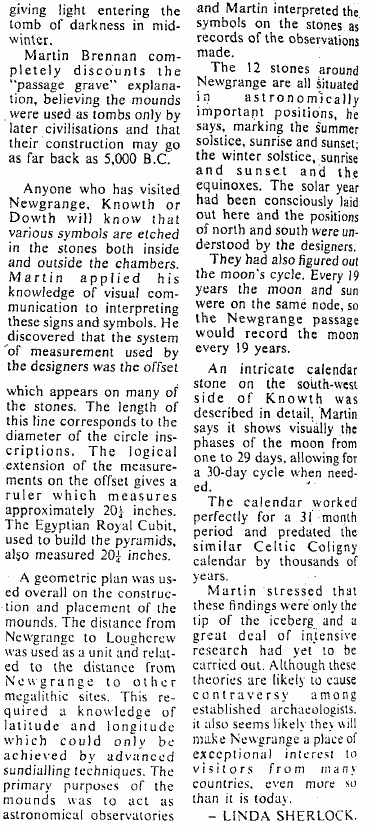Origins of Western Civilisation in Newgrange?
Linda Sherlock - Meath Chronicle May 24th 1980Ireland was the centre of stone age civilisation. The prehistoric mounds of Meath, located at Knowth, Dowth, Newgrange and Loughcrew, were constructed as astronomical observatories and the geometric and astronomical knowledge required in their construction pre-dated that of the ancient Greeks and Egyptians.
These theories may sound fantastic, but a sceptical audience assembled to hear Irish American Martin Brennan lecture on the monuments of the Boyne Valley in Navan Library recently, concluded that they were at least plausible following his lucid explanations and convincing illustrations. Controversy surrounds the findings of Martin Brennan. He is not an archaeologist; yet he claims to have "cracked the code" of Newgrange and similar mounds. His findings are published in his book, The Boyne Valley Vision.
Established archaeologists believe these sites were originally constructed as passage graves, used by the stone age civilisation to bury their dead. Radio-carbon dating of human remains at the Fourknocks and Tara mounds puts the period of burial at around 2.500 B.C. It has been known for some time that Newgrange records the winter solstice. On 21st December, the rising sun shines along the length of the 60 foot passage into the mound. Religious interpretations were placed on this fact, with emphasis on the symbolism of life giving light entering the tomb of darkness in mid-winter.
Martin Brennan completely discounts the "passage grave" explanation, believing the mounds were used as tombs only by later civilisations and that their construction may go as far back as 5,000 B.C. Anyone who has visited Newgrange, Knowth or Dowth will know that various symbols are etched in the stones both inside and outside the chambers.
Martin applied his knowledge of visual communication to interpreting these signs and symbols. He discovered that the system of measurement used by the designers was the offset which appears on many of the stones. The length of this line corresponds to the diameter of the circle inscriptions. The logical extension of the measurements on the offset gives a ruler which measures approximately 20.25 inches. The Egyptian Royal Cubit, used to build the pyramids, also measured 20.25 inches.
A geometric plan was used overall on the construction and placement of the mounds. The distance from Newgrange to Loughcrew was used as a unit and related to the distance from Newgrange to other megalithic sites. This required a knowledge of latitude and longitude which could only be achieved by advanced sun dialling techniques.
The primary purposes of the mounds was to act as astronomical observatories and Martin interpreted the symbols on the stones as records of the observations made. The 12 stones around Newgrange are all situated in astronomically important positions, he says, marking the summer solstice, sunrise and sunset, the winter solstice sunrise and sunset and the equinoxes.
The solar year had been consciously laid out here and the positions of north and south were understood by the designers. They had also figured out the moon's cycle. Every 19 years the moon and sun were on the same node, so the Newgrange Passage would record the moon every 19 years.
An intricate calendar stone on the south-west side of Knowth was described in detail. Martin says it shows visually the phases of the moon from one to 29 days, allowing for a 30-day cycle when needed.
The calendar worked perfectly for a 31 month period and predated the similar Celtic Coligny calendar by thousands of years. Martin stressed that these findings were only the tip of the iceberg and a great deal of intensive research had yet to be carried out.
Although these theories are likely to cause controversy among established archaeologists, it also seems likely they will make Newgrange a place of exceptional interest to visitors from many countries, even more so than it is today.
Linda Sherlock - Meath Chronicle May 24th 1980
Boyne Valley Private Day Tour
 Immerse yourself in the rich heritage and culture of the Boyne Valley with our full-day private tours.
Visit Newgrange World Heritage site, explore the Hill of Slane, where Saint Patrick famously lit the Paschal fire.
Discover the Hill of Tara, the ancient seat of power for the High Kings of Ireland.
Book Now
Immerse yourself in the rich heritage and culture of the Boyne Valley with our full-day private tours.
Visit Newgrange World Heritage site, explore the Hill of Slane, where Saint Patrick famously lit the Paschal fire.
Discover the Hill of Tara, the ancient seat of power for the High Kings of Ireland.
Book Now
Home
| Visitor Centre
| Tours
| Winter Solstice
| Solstice Lottery
| Images
| Local Area
| News
| Knowth
| Dowth
| Articles
| Art
| Books
| Directions
| Accommodation
| Contact




